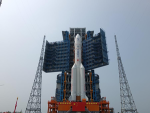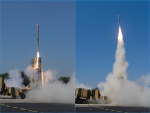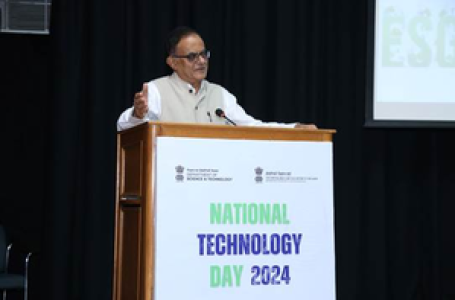
Sriharikota (Andhra Pradesh): India successfully put into orbit its third generation meteorological/weather satellite INSAT-3DS on Saturday evening in a copybook style. The 2,274 kg INSAT-3DS was carried by Geosynchronous Satellite Launch Vehicle (GSLV) rocket code-named as GSLV-F14.
The INSAT-3DS is India’s third generation meteorological satellite and is fully funded by the Ministry of Earth Sciences.
It is designed for enhanced meteorological observations and monitoring of land and ocean surfaces for weather forecasting and disaster warning. The satellite has a life span of 10 years.
INSAT-3DS augments the Meteorological services along with the presently operational INSAT-3D and INSAT-3DR in-orbit satellites, said Indian Space Research Organisation (ISRO).
At around 5.35 p.m., the three staged GSLV rocket standing 51.7 metre tall and weighing 420 tonnes rose up into the skies from the second launch pad here.
Breaking free from the Earth’s gravitational pull, the rocket went up and up with a bright orange fire at its tail.
As the GSLV rocket ascended towards the skies, its engine roar reverberated over the rocket port like a rolling thunder much to the thrill of the people there.
In the rocket mission control room, Indian space scientists at ISRO were glued to their computer screens watching the rocket’s flight progress.
Just over 19 minutes into the flight, the rocket slung INSAT-3DS into the Geosynchronous Transfer Orbit (GTO).
From there the satellite will be taken up by firing its on-board motors to its final position-the Geo-Stationary Orbit (GSO).
Various departments under the Ministry of Earth Sciences such as the India Meteorological Department (IMD), National Centre for Medium-Range Weather Forecasting (NCMRWF), the Indian Institute of Tropical Meteorology (IITM), National Institute of Ocean Technology (NIOT), the Indian National Centre for Ocean Information Services (INCOIS) and various other agencies and institutes will use the INSAT-3DS satellite data to provide improved weather forecasts and Meteorological services.
ISRO said the primary objectives of the mission are — to monitor the Earth’s surface, carry out oceanic observations and its environment in various spectral channels of meteorological importance; to provide the vertical profile of various Meteorological parameters of the atmosphere; to provide data collection and data dissemination capabilities from the data collection platforms (DCPs); and to provide satellite-aided search and rescue services.
According to ISRO, Indian industries have significantly contributed in the making of the INSAT-3DS.
The satellite carries six Channel Imager, 19 Channel Sounder payload, Data Relay Transponder (DRT) and Satellite aided Search and Rescue (SA&SR) transponders.
Imager and Sounder payloads are similar to the payloads flown on INSAT-3D and INSAT-3DR with significant improvements in radiometric performances.
The Indian space agency said the Sounder will provide information on the vertical profiles of the Atmosphere – temperature, humidity and others.
The DRT receives globally Meteorological, Hydrological and Oceanographic data from automatic data collection platforms/Automatic Weather Stations (AWS) from multi-user and relays back to user terminal.
The SA&SR relays a distress signal / alert detection from the beacon transmitters for search and rescue purposes with ‘global receive’ coverage in UHF band.
The GSLV-F14 rocket is a three staged/engine vehicle.
The first stage (GS1) is powered by a solid propellant motor having 139-tonne propellant and four earth-storable propellant stages strap-on motors with 40 tonnes of liquid propellant in each.
The second stage is also an earth-storable propellant stage loaded with 40 tonne propellant.
The third stage is a cryogenic stage with a 15-tonne propellant loading of liquid oxygen (LOX) and liquid hydrogen (LH2).
During the atmospheric regime, the satellite is protected by Ogive payload fairing or the heat shield.
GSLV rocket can be used to launch a variety of spacecraft capable of performing communications, navigation, earth resource surveys, and any other proprietary mission, ISRO said.
IANS



















